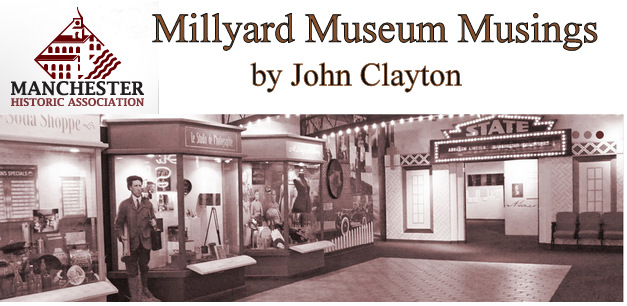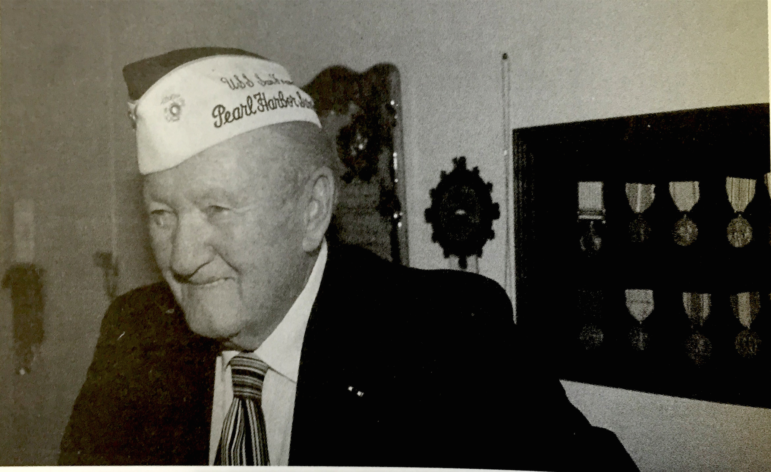
It’s hard to believe that 20 years have passed since I wrote this piece about my friend, Walter Welch. Walter has since passed as well, but his story about what he witnessed at Pearl Harbor is timeless… JC
It was Wednesday, Dec. 3, 1941. A Marine Corps sergeant named Walter Welch took advantage of a day’s liberty and left his ship – the U.S.S. San Francisco – to go visit a buddy from Manchester.
His name was Joe Rozmus. He was a sailor whose ship was anchored just across the bay in Pearl Harbor.
”We made plans to go to Waikiki Beach on Sunday,” Walter said.
They never made it.
Instead of a day at the beach, Walter and his comrades endured a day in hell. At 7:45 that Sunday morning, he was leading a color guard onto the fantail of the San Francisco when the first Japanese planes were spotted.
When the day was over, President Roosevelt called it a date that ”will live in infamy.” For Walter Welch, it was the date he watched his friend’s ship – the U.S.S. Arizona – destroyed by Japanese bombs.
”I’ll never forget it as long as I live,” he said. ”I was standing aft and I saw it get hit. The explosions were horrible. I saw men and debris flying through the air and I saw it break in half. There’s a fellow from Manchester who lives in Merrimack now, Bob Lefabvre. He was on the deck of the West Virginia and the blast from the Arizona blew him right off his ship.”
Joe Rozmus died that day. So did 1,176 others aboard the Arizona. All told, 2,403 died – including others from Manchester like Seaman 1st Class David Crossett and Sgt. Maurice St. Germain and Pvt. Joseph Jedrysik – in the attack that occurred 74 years ago today.

It wasn’t easy for Walter to talk about it when we sat down in his kitchen 20 years ago, as his wife Toni made us coffee. Sometimes the memories of that Sunday morning on Pearl remained all too vivid for the survivors.
”It’s not too bad when people ask direct questions, like ‘What kind of ship was the Arizona?’ or ‘How many people were killed?”’ Walter said . ”It’s when they ask you what you were feeling that day. That’s when the memories start to get the better of you.”
Perhaps it was because the memories involved anger and rage. Most of all, his memories involved frustration.
”We were Marines, but we weren’t sea-going bellhops on board ship,” he said. ”We manned five-inch anti-aircraft guns. Mine was on the port side and we were trained to fire four shells in 16 seconds and we could hit a target as far as 3,200 yards away.”
All of that training flashed through his mind when he saw those first planes – maybe a dozen of them – swoop over Hickam Field and make their way toward battleship row. He saw the insignia of the Rising Sun and he heard the loudspeaker bark to life: ”The island of Oahu is under attack – all men to battle stations.”
On board the San Francisco, it was a futile command.
”We were supposed to go into dry dock for overhaul on Monday,” Walter said. ”We had to make the ship lighter. Two days earlier, we had unloaded our turret ammunition and our anti-aircraft shells. Three thousand rounds.”
Knowing their big guns had been rendered useless, Welch led his four-man detail below deck where they were able to grab four Browning automatic rifles. They hefted boxes of ammo, bolted topside and started firing at the bombers overhead. The memory made Walter shake his head. ”Firing at a bomber with a BAR,” he said softly before looking away.
Those were the memories that hit him the hardest, the ones that brought back the sense of helplessness he felt that day. For all of the personal pain, however, it was a memory he kept alive. It’s a memory he shared with youngsters when he visited schools here in his hometown of Manchester.
To help the kids understand what happened that day, this most meticulous man had a carefully prepared set of diagrams. He had a time line and photographs and maps to share but the most important part of his presentation – the part that brought Pearl Harbor to life for those kids – is the story they heard from this eyewitness to history.
More than the charts, it was what was in his heart.

John Clayton is Executive Director of the Manchester Historic Association. You can reach him with your historical (or existential) questions at jclayton@manchesterhistoric.org.
 You’re one click away! Sign up for our free eNewsletter and never miss another thing.
You’re one click away! Sign up for our free eNewsletter and never miss another thing.







